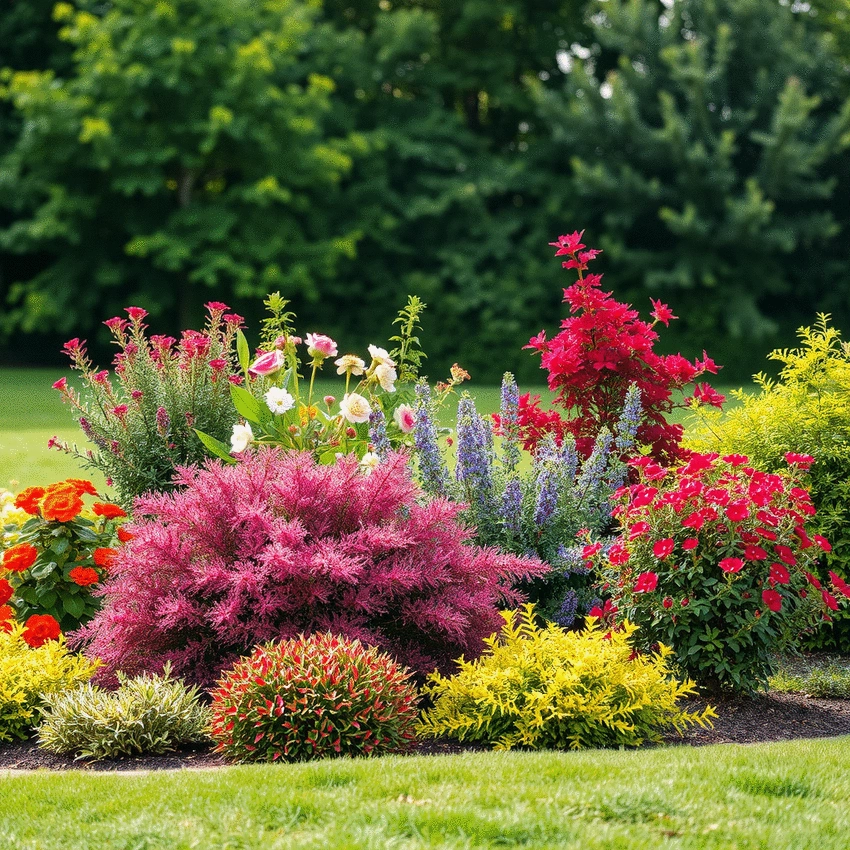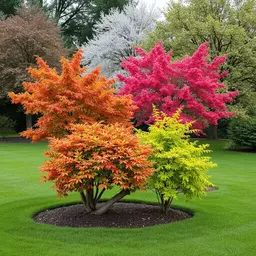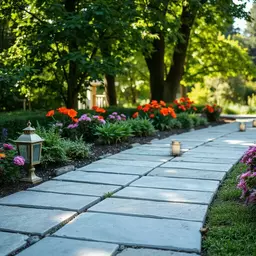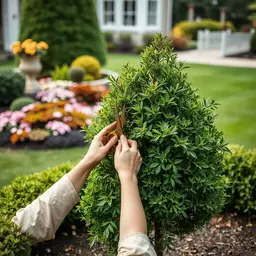Year-Round Trees for Your Landscape
By Celia Fairchild / Nov 02
Have you ever considered how shrubs can transform your outdoor space? Beyond mere decoration, they play a crucial role in enhancing the beauty and health of your garden, fostering vibrant ecosystems, and providing essential benefits. Discover the profound impact of these often-overlooked plants in your landscaping journey!
Explore the essential characteristics that make shrubs a vital component of outdoor aesthetics and ecology.
Enhances visual interest with varying shapes, sizes, and colors.
Offers blooms or foliage changes throughout the year for year-round interest.
Act as windbreaks, privacy screens, or noise barriers while controlling soil erosion.
Provide shelter for wildlife, support pollinators, and improve air quality.
When it comes to creating a visually appealing garden, shrubs play a vital role that often goes unnoticed. They serve not only as decorative elements but also contribute to the overall health of your landscape. At Ornamental Yard, I believe that understanding the aesthetic, ecological, and functional importance of shrubs is key to designing beautiful outdoor spaces. For more insights on enhancing your outdoor space, consider these elegant landscaping with decorative trees ideas.
By incorporating shrubs, you can foster a diverse ecosystem that benefits both your garden and the local environment. Shrubs provide shelter for wildlife, support pollinators, and even improve air quality. Their presence adds layers to your garden design, making it more inviting and rich in texture.
So, what makes shrubs such an essential part of garden design? First and foremost, they add structure and depth to your layout. Whether you're creating defined borders or softening harsh edges, shrubs can help create a sense of balance in your space. Here are a few reasons why shrubs matter:
Also, shrubs can help control soil erosion and improve air circulation, promoting healthy growth for other plants. With their many benefits, it's clear that shrubs are a must-have in any well-designed landscape!
When selecting shrubs for your landscape, it's crucial to consider their aesthetic attributes. The bloom color, shape, and seasonal interest can greatly enhance the overall beauty of your garden. Here are some key attributes to think about:
For instance, a flowering shrub like Hydrangea brings vibrant pops of color during the summer, while evergreens like Boxwood maintain a lush green backdrop throughout the winter. By thoughtfully selecting your shrubs based on these attributes, you can elevate the aesthetic of your outdoor space! Learn more about choosing shrubs with strong visual appeal.
Now that we understand the importance of shrubs, let’s explore some specific categories that can significantly enhance the visual appeal of your garden. Different shapes and sizes can create dynamic landscapes that draw the eye and invite exploration.
Columnar and conical shrubs are excellent for adding height and structure to your garden. They serve as beautiful vertical elements that can frame pathways or accentuate focal points. Some popular choices include:
These shrubs not only create visual interest but also help guide the eye upward, making your garden feel more expansive. By incorporating these vertical elements, you can transform a flat landscape into a multi-dimensional oasis! For those with limited space, a guide to elegant shrubs for small gardens can be particularly helpful.
On the other hand, round and vase-shaped shrubs are perfect for softening edges and creating inviting spaces. Their gentle curves can enhance the comfort of your garden while adding a touch of whimsy. Consider these lovely options:
Using these types of shrubs can make your garden feel more welcoming, encouraging you and your guests to linger and enjoy the beauty around you. With these enchanting forms, your outdoor space will truly shine!
Flowering shrubs are a must in any garden that aims for seasonal beauty. Shrubs like Azalea, Hydrangea, and Butterfly Bush not only provide stunning blooms but also create visual impact that can transform your landscape. Here’s a closer look:
By incorporating these flowering shrubs, you’ll ensure that your garden is not only visually appealing but also full of life and activity. Imagine stepping outside to a garden alive with color and buzzing with energy—what a joy that would be! When choosing shrubs, remember to also consider how selecting ornamental shrubs for landscaping can complement your overall garden design.
Here's a brief recap of the key points discussed so far:
When planning a garden, it's essential to consider how your choices impact the environment. By integrating sustainability into your shrub selections, you can create a beautiful landscape while supporting local ecosystems. Choosing the right shrubs can make a significant difference in reducing water usage and promoting biodiversity, which is something I’m passionate about at Ornamental Yard!
One of the most effective ways to achieve sustainability is by selecting shrubs that are native to your region. These plants are adapted to local soil and climate conditions, making them more resilient and easier to maintain. Plus, native shrubs often provide crucial habitat and food for local wildlife. Let’s explore some important points to consider when choosing your shrubs!
When it comes to creating a sustainable garden, the debate between native and exotic shrubs is vital. Native shrubs are those that naturally occur in your area, while exotic shrubs are introduced species from other regions. Here are some compelling reasons to opt for native varieties:
Incorporating native shrubs into your garden is a step toward a more sustainable and thriving landscape. I always encourage homeowners to look for local resources that can guide them in selecting the best native options!
Supporting biodiversity is another crucial aspect of sustainable gardening. By selecting shrubs that attract pollinators, you can help create a vibrant ecosystem in your yard. Here are some beautiful pollinator-friendly shrubs to consider:
By incorporating these shrubs into your landscape, you’re not just enhancing beauty, but also playing a vital role in supporting pollinator populations. At Ornamental Yard, I love to see the joy that these plants bring to both gardens and wildlife!
Another way to enhance the aesthetics and sustainability of your garden is by pairing shrubs with ornamental grasses and companion plants. Ornamental grasses add texture and movement, creating a dynamic visual experience. Here’s how to make the most of these combinations:
Such combinations not only make your garden visually appealing but also enhance the ecosystem by attracting diverse wildlife. I encourage my clients at Ornamental Yard to experiment with these pairings for a stunning effect!
As you embark on your journey to enhance your outdoor space with shrubs, you might have questions about selection and care. Let’s address some common queries that many gardeners have!
Here are some frequently asked questions that can help you make informed decisions about your shrub choices:
These questions are great starting points for anyone looking to dive into shrub selection and care. I’m always here to provide guidance at Ornamental Yard!
In addition to these FAQs, I want to empower you with resources that can assist you on your landscaping journey. Here are some helpful links to get you started:
These resources will support you as you create the garden of your dreams. Remember, every step you take towards sustainable gardening makes a difference!
As we wrap up our exploration of shrubs in landscaping, I hope you feel inspired to make thoughtful choices that benefit both your garden and the environment. Remember, selecting the right shrubs can create lasting beauty and ecological health! For more information on maintaining your garden, check out these essential tips for tree care that can also apply to shrubs.
Consider your unique garden needs and the ecological impact of your choices. By choosing native and pollinator-friendly shrubs, you're not just enhancing your outdoor aesthetics—you're also contributing to a healthier ecosystem. It's a win-win!
I would love to hear from you! Share your landscaping experiences or ask questions in the comments below. Together, we can create stunning gardens that reflect our love for nature and promote sustainability!
Here is a quick recap of the important points discussed in the article:

 Year-Round Trees for Your Landscape
Have you ever considered how the right trees can transform your garden into a year-round masterpiece
Year-Round Trees for Your Landscape
Have you ever considered how the right trees can transform your garden into a year-round masterpiece
 Creative Walkway Design Ideas
What if your walkway could do more than just lead the way? With the right design, it can enhance you
Creative Walkway Design Ideas
What if your walkway could do more than just lead the way? With the right design, it can enhance you
 Pruning Tips for Ornamental Shrubs
In the world of gardening, pruning isn't just a routine task; it’s an art that can greatly influen
Pruning Tips for Ornamental Shrubs
In the world of gardening, pruning isn't just a routine task; it’s an art that can greatly influen